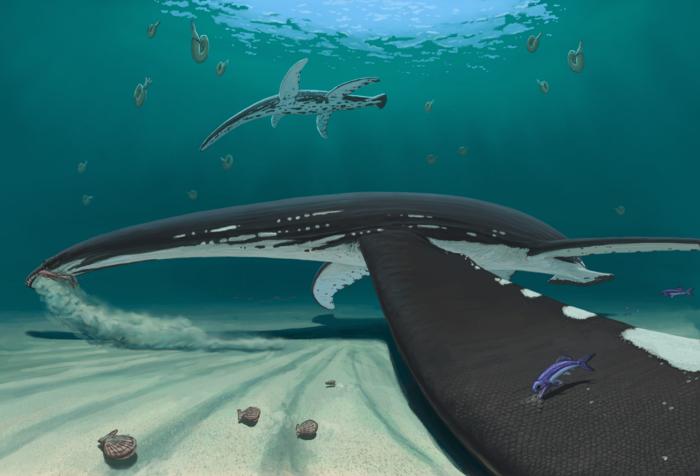
183-Million-Year-Old Fossil Reveals That Plesiosaur Skin Was Smooth and Scaly
www.discovermagazine.com
Is it better to be smooth or to be scaly? For fossil plesiosaurs around 183 million years ago, the answer was a bit of both. Scrutinizing some of the first soft tissues from a fossil plesiosaur in a study in Current Biology, a team of researchers has revealed that these massive marine reptiles sported both smooth and scaly skin, potentially suited to swimming as well as to skimming or bottom-walking over the seafloor.Fossilized soft tissue, such as skin and internal organs, is exceptionally rare, said Miguel Marx, lead study author and a geology graduate student at Lund University in Sweden, in a press release. We used a broad range of techniques to identify smooth skin in the tail region as well as scales along the rear edge of the flippers. This provided us with unparalleled insights into the appearance and biology of these long-extinct reptiles.Read More: Why Were Prehistoric Marine Reptiles So Huge?Plesiosaur Skin Fit For Swimming (And Skimming)Soft tissues preserve a fossil plesiosaurs smooth and scaly skin. (Credit: Klaus Nilkens/Urwelt-Museum Hauff)The plesiosaurs, the large marine reptiles that thrived in the oceans of the Mesozoic around 203 million to 66 million years ago, werent wholly unlike the modern marine animals of today. Reaching lengths of as many as 40 feet long, these reptiles had long necks, broad bodies, and flat flippers, resulting in a loose resemblance to a modern-day sea turtle, both in terms of their looks and their methods of movement. The skin of the plesiosaurs and its similarity to that of modern marine animals has been something of a mystery, however, as few fossil specimens have had any traces of soft tissues preserved. Turning to a 183-million-year-old plesiosaur fossil from Germanys Posidonia Shale, researchers have now provided novel insights into plesiosaur skin in the Jurassic period, revealing a strange mixture of smooth on the tail and scaly on the flippers. Perhaps suited to the plesiosaurs predation strategies, it is possible that the animals smooth skin added to its speed, increasing its agility as it swam after fish, while its scaly, turtle-like skin added to its stability, steadying its movement as it swam. It is also possible, according to the researchers, that the scaly skin supported the animal as it skimmed or bottom-walked over the seafloor in search of food, though the idea that these creatures fed at the bottom of the ocean is still disputed. Our findings help us create more accurate life reconstructions of plesiosaurs, something that has been extremely difficult since they were first studied over 200 years ago, Marx said in a press release.Precisely PreservedPreserved at the tip of the plesiosaurs flipper are two turtle-like scales, shown above. (Credit: Klaus Nilkens/Urwelt-Museum Hauff)Though the 15-foot fossil was freed from the Posidonia Shale in 1940, it wasnt until 2020 that the preserved soft tissues around its tail and front flippers were found. Imaging the specimen, which is housed at the Urwelt-Museum Hauff in Holzmaden, Germany, with an assortment of techniques and analyzing its molecular makeup, the team found that the tissues were so precisely preserved that the individual skin cells were able to be studied.Apart from the mosaic of smooth skin and scales, it was an incredible moment to visualize the cells in thin sections of the fossilized plesiosaurs skin, Marx said in a press release. I was shocked when I saw skin cells that had been preserved for 183 million years. It was almost like looking at modern skin.Ultimately, the researchers results reveal the looks and locomotion of the plesiosaurs in new detail, uncovering the smooth and scaly adaptations that allowed them to thrive. The well-preserved German fossil really highlights the potential for soft tissue in providing valuable insights into the biology of these long-extinct animals, Marx said in a press release.Article SourcesOur writers at Discovermagazine.com use peer-reviewed studies and high-quality sources for our articles, and our editors review for scientific accuracy and editorial standards. Review the sources used below for this article:Current Biology. Skin, Scales, and Cells in a Jurassic PlesiosaurSam Walters is a journalist covering archaeology, paleontology, ecology, and evolution for Discover, along with an assortment of other topics. Before joining the Discover team as an assistant editor in 2022, Sam studied journalism at Northwestern University in Evanston, Illinois.
0 Comments
·0 Shares
·71 Views


